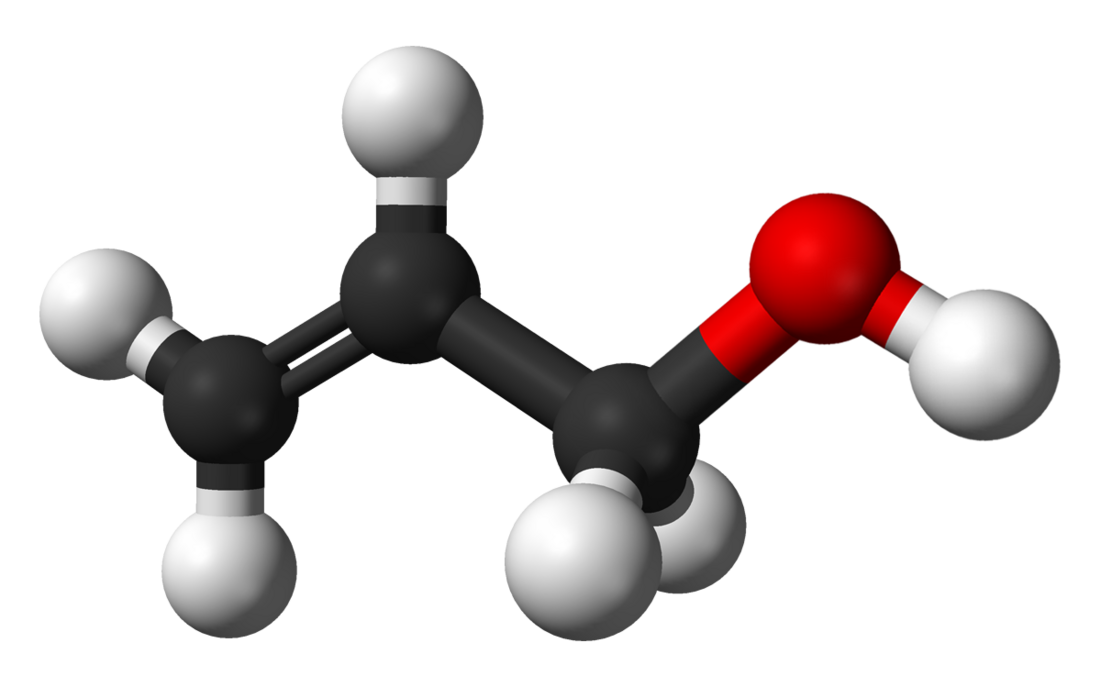Allyl alcohol
Organic compound (CH2=CHCH2OH) From Wikipedia, the free encyclopedia
Allyl alcohol (IUPAC name: prop-2-en-1-ol) is an organic compound with the structural formula CH2=CHCH2OH. Like many alcohols, it is a water-soluble, colourless liquid. It is more toxic than typical small alcohols. Allyl alcohol is used as a precursor to many specialized compounds such as flame-resistant materials, drying oils, and plasticizers.[5] Allyl alcohol is the smallest representative of the allylic alcohols.
 | |
 | |
| Names | |
|---|---|
| Preferred IUPAC name
Prop-2-en-1-ol | |
| Other names
Allyl alcohol 2-Propen-1-ol 1-Propen-3-ol[1] Vinyl carbinol[1] Allylic alcohol Weed drench[citation needed] | |
| Identifiers | |
3D model (JSmol) |
|
| ChEBI | |
| ChEMBL | |
| ChemSpider | |
| ECHA InfoCard | 100.003.156 |
| EC Number |
|
| KEGG | |
PubChem CID |
|
| RTECS number |
|
| UNII | |
| UN number | 1098 |
CompTox Dashboard (EPA) |
|
| |
| |
| Properties | |
| C3H6O | |
| Molar mass | 58.080 g·mol−1 |
| Appearance | colorless liquid[1] |
| Odor | mustard-like[1] |
| Density | 0.854 g/ml |
| Melting point | −129 °C (−200 °F; 144 K) |
| Boiling point | 97 °C (207 °F; 370 K) |
| Miscible | |
| Vapor pressure | 17 mmHg[1] |
| Acidity (pKa) | 15.5 (H2O)[2] |
| −36.70·10−6 cm3/mol | |
| Hazards | |
| Occupational safety and health (OHS/OSH): | |
Main hazards |
Highly toxic, lachrymator |
| GHS labelling: | |
    | |
| Danger | |
| H225, H301, H302, H311, H315, H319, H331, H335, H400 | |
| P210, P233, P240, P241, P242, P243, P261, P264, P270, P271, P273, P280, P301+P310, P302+P352, P303+P361+P353, P304+P340, P305+P351+P338, P311, P312, P321, P322, P330, P332+P313, P337+P313, P361, P362, P363, P370+P378, P391, P403+P233, P403+P235, P405, P501 | |
| NFPA 704 (fire diamond) | |
| Flash point | 21 °C (70 °F; 294 K) |
| 378 °C (712 °F; 651 K) | |
| Explosive limits | 2.5–18.0% |
| Lethal dose or concentration (LD, LC): | |
LD50 (median dose) |
80 mg/kg (rat, orally)[3] |
LC50 (median concentration) |
1000 ppm (mammal, 1 hr) 76 ppm (rat, 8 hr) 207 ppm (mouse, 2 hr) 1000 ppm (rabbit, 3.5 hr) 1000 ppm (monkey, 4 hr) 1060 ppm (rat, 1 hr) 165 ppm (rat, 4 hr) 76 ppm (rat, 8 hr)[4] |
| NIOSH (US health exposure limits): | |
PEL (Permissible) |
2 ppm[1] |
REL (Recommended) |
TWA 2 ppm (5 mg/m3) ST 4 ppm (10 mg/m3) [skin] [1] |
IDLH (Immediate danger) |
20 ppm[1] |
| Safety data sheet (SDS) | External MSDS |
Except where otherwise noted, data are given for materials in their standard state (at 25 °C [77 °F], 100 kPa).
| |
Production
Summarize
Perspective
Allyl alcohol is produced commercially by the Olin and Shell corporations through the hydrolysis of allyl chloride:
- CH2=CHCH2Cl + NaOH → CH2=CHCH2OH + NaCl
Allyl alcohol can also be made by the rearrangement of propylene oxide, a reaction that is catalyzed by potassium alum at high temperature. The advantage of this method relative to the allyl chloride route is that it does not generate salt. Also avoiding chloride-containing intermediates is the "acetoxylation" of propylene to allyl acetate:
- CH2=CHCH3 + 1/2 O2 + CH3CO2H → CH2=CHCH2O2CCH3 + H2O
Hydrolysis of this acetate gives allyl alcohol. In alternative fashion, propylene can be oxidized to acrolein, which upon hydrogenation gives the alcohol.
In principle, allyl alcohol can be obtained by dehydrogenation of propanol.
Laboratory methods
In the laboratory, glycerol reacts with oxalic or formic acids to give (respectively) dioxalin or glyceric formate, either of which decarboxylate and dehydrate to allylol.[6][7]
Allyl alcohols in general are prepared by allylic oxidation of allyl compounds, using selenium dioxide or organic peroxides. Other methods include carbon-carbon bond-forming reactions such as the Prins reaction, the Morita-Baylis-Hillman reaction, or a variant of the Ramberg-Bäcklund reaction. Hydrogenation of enones is another route. Some of these methods are achieved by the Luche reduction, Wharton reaction, and the Mislow-Evans rearrangement.
Allyl alcohol was first prepared in 1856 by Auguste Cahours and August Hofmann by hydrolysis of allyl iodide.[5] Today a Allyl alcohol can be formed after trituration of garlic (Allium sativum) cloves (producing from garlic in two ways: firstly by a self-condensation reaction of allicin and its decomposition products such as diallyl trisulphide and diallyl disulphide and secondly by the reaction between alliin, the precursor of allicin, and water).[8]
Applications
Allyl alcohol is converted mainly to glycidol, which is a chemical intermediate in the synthesis of glycerol, glycidyl ethers, esters, and amines. Also, a variety of polymerizable esters are prepared from allyl alcohol, e.g. diallyl phthalate.[5]
Allyl alcohol has herbicidal activity and can be used as a weed eradicant[9]) and fungicide.[8]
Allyl alcohol is the precursor in the commercial synthesis of allyl bromide:[10]
- CH2=CHCH2OH + HBr → CH2=CHCH2Br + H2O
Safety
Allyl alcohol is hepatotoxic. In rats, in vivo, allyl alcohol is metabolized by liver alcohol dehydrogenase to acrolein, which can cause damage to the microtubules of rat hepatocyte mitochondria and depletion of glutathione.[8] It is significantly more toxic than related alcohols.[5][11] Its threshold limit value (TLV) is 2 ppm. It is a lachrymator.[5]
See also
References
External links
Wikiwand - on
Seamless Wikipedia browsing. On steroids.

